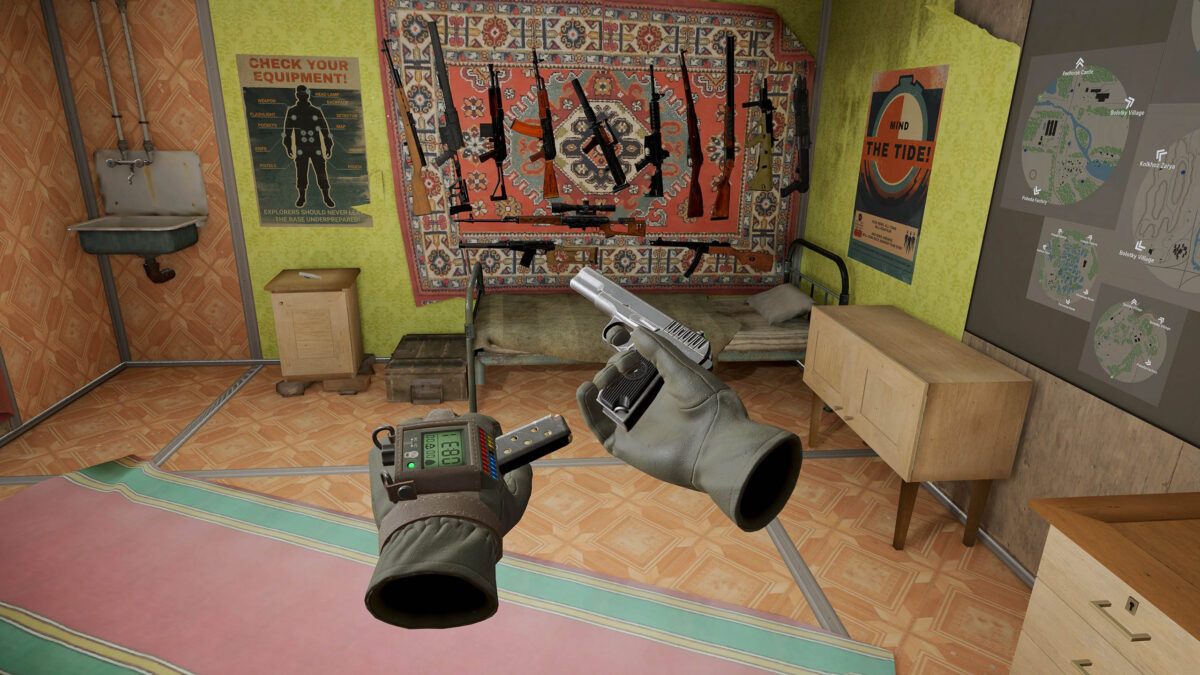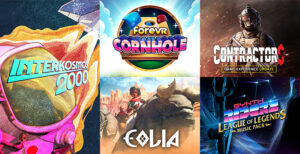Pechorsk isn’t for the faint of heart. The town is in a state of constant decay, mysterious creatures are running amok, and there’s no one else around to back you up. This is the harsh, post-apocalyptic environment of Into the Radius, a single-player survival shooter that’s now available on Meta Quest 2 for $29.99 USD.
You find yourself in the titular Radius at the beginning of the game, and your only companion is an eerie ring of light perched in the sky. Before venturing outside of your base, you’ll have to prepare for environmental anomalies—like toxic gas and floating balls of lightning—as well as encounters with hostile, shadow-like creatures that’ll attack you on sight. To increase your chances of survival, you’ll need to improve your weapons (and properly maintain them so they don’t jam on you) and equipment by scavenging anything you can find.
The base’s computer terminal will help you uncover the story and reward you for completing different missions, thus providing additional resources for your excursions. Unlike other FPS games, Into the Radius isn’t about racking up as many kills as you can or destroying everything you see. It’s a methodical game, one that requires a lot of patience and spatial awareness. The more stealthy and careful you are, the better.
To find out more about Into the Radius, we spoke with Producer Alexei Shulga about dystopian fiction, what’s changed in the game since its early access release on PC VR, and how the community helped create an unlikely mascot.
Tell us a bit about CM Games. How did you get into VR development?
Alexei Shulga: The studio was founded back in 2010 but had been focused exclusively on mobile games throughout its initial years. This changed when we got our hands on the Rift DK1 and got excited about entirely new ways of experiencing games in VR. Into the Radius evolved from my personal passion project, slowly gathering support and interest in the studio. After the initial PC VR alpha release, we saw significant traction in the player community and slowly built upon that to become a full-blown, autonomous VR team developing multiple games.
What was the inspiration behind Into the Radius?
AS: We’ve drawn clear inspiration from the novel Roadside Picnic by Arkady and Boris Strugatsky and the S.T.A.L.K.E.R games franchise. But we place more focus on the surreal-horror aspects of the anomalous zone theme. I was always fascinated by the concept of humanity encountering an entity so advanced that we can’t even begin to comprehend it.
Also, I drew lots of inspiration from my life experiences: exploring crumbling industrial areas as a child, serving in the army, and being an airsoft player. Perhaps that’s one of the reasons I wanted to challenge the conventional ways some gameplay mechanics are done in games.
In addition to true-to-life weapon handling and inventory management, there are more subtle features in Into the Radius. For example, enemies remember where they spotted the player last and deliver suppressive fire to that location, so an intelligent player should change cover often and be aware of their surroundings. The immersion enabled by VR makes this a really intense testing experience.
Is there a specific story you’re telling in the game, or is it more of an open-ended experience?
AS: There’s a main story that players experience, setting the backdrop and guiding their progression. But it’s not holding your hand—being free to explore on your own and at your desired pace is a key element of the exploration and survival genre.
You’ve been working on Into the Radius for several years now, first on PC VR and now on Quest 2. How has the game changed over time?
AS: The game has changed quite drastically and seen multiple significant overhauls. The first alpha version was more like a single-player battle royale where you spawn into the zone in a random spot and need to scavenge for weapons before attempting to complete the mission. It was intense but resulted in a steep learning curve, especially for players who weren’t proficient yet with VR FPS mechanics.
The release version had one large map where all the missions took place, but this presented us with lots of pacing and performance issues that hampered further development from both a quality of life and game design perspectives. This realization and the desire to keep improving the game long-term resulted in version 2.0 with a complete graphics overhaul, redesigned economics, and new mechanics like The Tide.
How much of those updates and improvements were influenced by player feedback?
AS: We’re very player feedback-driven. We’re blessed with a passionate Discord community that’s always willing to share their experience, opinions, and ideas.
That being said, a developer’s job is not only to listen but to get to the root of player pain points and design the best solutions. Often, the ways we solve problems are not exactly what the players suggest because we need to align these changes with other upcoming features, the long-term vision for the game, and specific technical and design constraints. But there are quite a number of cases where we have implemented players’ ideas one-to-one, exactly how they were voiced on Discord or Reddit. And we always keep a running list of fantastic suggestions for future updates.
Were there any challenges you faced while optimizing the game for a mobile chipset? How did you overcome them?
AS: The whole game was one epic challenge! Vast open areas, lots of foliage, dynamic day and night cycles, players being free to place hundreds of items wherever they want, monsters that roam and can hear a gunshot from afar and come to say “hello”—that’s just to name a few.
We didn’t want to cut any features or change the experience too much. So we needed to look at each feature one by one, identify the most resource-intensive part of it, and come up with either a direct optimization, a change that would work differently but feel the same, or reduce fidelity as the last-resort measure.
The most significant opportunity in graphics optimization was building against just one specific chipset so that we could optimize against its strengths thanks to a deep understanding of the hardware. Investing in profound rendering expertise in the team is critical for a game of such scope and complexity.
Do you have any favorite moments or anecdotes from playing the game?
AS: I have a very fond memory from one of the early days of development. There were no saves at the time. I was playing a mission to retrieve an artifact, and by the time I reached the objective, night fell. I was low on health, and the artifact was inside a field of nearly invisible lightning anomalies.
To make things worse, I could hear the distinct sound of monsters moving nearby. So I was crouching through the field, and when I finally found my way out with the artifact, it was gratifying, like living through a forgotten childhood memory. It’s one of those moments that I wanted to share with players. Not necessarily through gameplay difficulty, but by maintaining the same immersion and sense of agency.
How do you plan on updating Into the Radius in the future?
AS: The same as we’ve done with the PC VR version in past years—we deliver a major update every two to three months, give or take, depending on the scope of the update. We do not publish development roadmaps because we like to stay agile and be able to respond to feedback. That’s hard to do if you’ve already promised a year’s worth of work ahead of time.

Do you have any tips for players before they enter the Radius?
AS: Yes!
- Try not to rush forward with guns blazing. It’s the best way to die.
- Always be aware of your surroundings—all anomalies and enemies have distinct sounds that can give you a warning well in advance. You can even do a drill where you stand still and listen for a second every now and then to try to assess the environment.
- You can practice reloading and aiming in the shooting range, and engage in some fun minigames. Your gun is only as good as you can operate it.
- Cover is an Explorer’s best friend: It can prevent you from being exposed, shield you from enemy fire, or be used to break line of sight to get a tactical advantage over groups of enemies.
Anything else you’d like to share with our readers?
AS: There’s a funny story about what can happen once you apply a live-game approach to development. The Radius is populated by tiny, fast-moving tentacle monsters called Spawns. In one of the updates, we introduced a bug where they would not attack the player under some conditions and instead bounce around very close to their feet.
We quickly fixed the bug, but suddenly faced a massive outcry in the community. People were demanding, “Why did you kill Pecho?”, “Where is Pecho? Bring him back!” etc. We were baffled. Like, who is this Pecho in the first place?
After a thorough investigation on Discord, we realized that players were using that bug to domesticate the Spawns, play with them using hand physics, and even give the friendly Spawn a name: Pecho (derived from Pechorsk, the town where the game takes place).
For a moment, we were tempted to roll back the bug fix but decided that simply doing so wouldn’t meet our quality standards. Instead, we incorporated Pecho into multiple emojis and various artworks used in the community and promised to turn it into something in-game one day.
You can start investigating the mysteries of Pechorsk in Into the Radius for Quest 2 today.
- AR/VR
- blockchain
- blockchain conference ar
- blockchain conference vr
- coingenius
- crypto conference ar
- crypto conference vr
- extended reality
- Metaverse
- mixed reality
- Oculus
- oculus games
- oppo
- plato
- plato ai
- Plato Data Intelligence
- PlatoData
- platogaming
- robot learning
- telemedicine
- telemedicine companies
- Virtual reality
- virtual reality game
- virtual reality games
- vr
- zephyrnet













